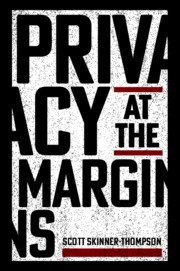Book contents
- Reviews
- Privacy at the Margins
- Privacy at the Margins
- Copyright page
- Dedication
- Contents
- Acknowledgments
- Introduction
- 1 No Privacy in Public = No Privacy for the Precarious
- 2 Performative Privacy in Theory and Practice
- 3 Performative Privacy’s Payoffs
- 4 Containing Corporate and Privatized Surveillance
- 5 Outing Privacy as Anti-Subordination
- 6 Equal Protection Privacy
- Conclusion
- Index
1 - No Privacy in Public = No Privacy for the Precarious
Published online by Cambridge University Press: 22 October 2020
- Reviews
- Privacy at the Margins
- Privacy at the Margins
- Copyright page
- Dedication
- Contents
- Acknowledgments
- Introduction
- 1 No Privacy in Public = No Privacy for the Precarious
- 2 Performative Privacy in Theory and Practice
- 3 Performative Privacy’s Payoffs
- 4 Containing Corporate and Privatized Surveillance
- 5 Outing Privacy as Anti-Subordination
- 6 Equal Protection Privacy
- Conclusion
- Index
Summary
Broadly speaking, both privacy doctrine and public discourse suggest that the right to privacy is significantly diminished once one enters the public realm or once one’s information is shared with others.1 In fact, certain doctrines provide that the right to privacy while in public is nearly nonexistent, that privacy is more or less “dead” once you walk out your front door or expose your activities to anyone else – even if you are fortunate enough to have your own property and still be on it.2 Pursuant to this conception of the right to privacy, privacy is synonymous with secrecy – and, as described by Daniel Solove, this “secrecy paradigm” greatly limits legal protection for privacy.
Keywords
- Type
- Chapter
- Information
- Privacy at the Margins , pp. 8 - 44Publisher: Cambridge University PressPrint publication year: 2020
- 1
- Cited by

